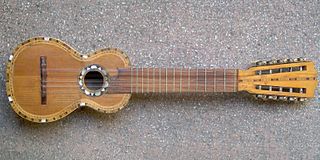
The charango is a small Andean stringed instrument of the lute family, from the Quechua and Aymara populations in the territory of the Altiplano in post-Colonial times, after European stringed instruments were introduced by the Spanish during colonialization. The instrument is widespread throughout the Andean regions of Bolivia, Peru, Ecuador, northern Chile and northwestern Argentina, where it is a popular musical instrument that exists in many variant forms.
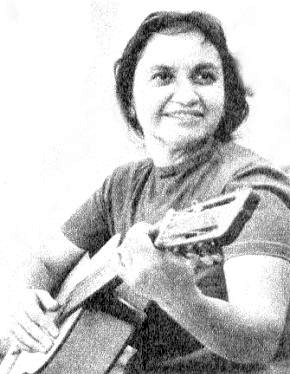
Violeta del Carmen Parra Sandoval was a Chilean composer, singer-songwriter, folklorist, ethnomusicologist and visual artist. She pioneered the Nueva Canción Chilena, a renewal and a reinvention of Chilean folk music that would extend its sphere of influence outside Chile.
The music of Bolivia has a long history. Out of all the Andean countries, Bolivia remains perhaps the most culturally linked to the indigenous peoples.
Chilean music refers to all kinds of music developed in Chile, or by Chileans in other countries, from the arrival of the Spanish conquistadors to the modern day. It also includes the native pre-Columbian music from what is today Chilean territory.
Peruvian music is an amalgamation of sounds and styles drawing on Peru's Andean, Spanish, and African roots. Andean influences can perhaps be best heard in wind instruments and the shape of the melodies, while the African influences can be heard in the rhythm and percussion instruments, and European influences can be heard in the harmonies and stringed instruments. Pre-Columbian Andean music was played on drums and string instruments, like the European pipe and tabor tradition. Andean tritonic and pentatonic scales were elaborated during the colonial period into hexatonic, and in some cases, diatonic scales.
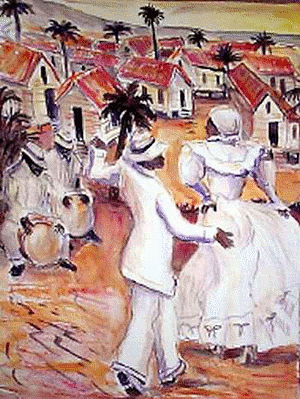
Bomba is an umbrella term that refers to a variety of musical styles and associated dances originating in Puerto Rico. It was developed by enslaved Africans and their descendants in sugar plantations along coastal towns, most notably Loiza, Mayagüez, Ponce, and San Juan, during the 17th century. It is the island's oldest musical tradition.
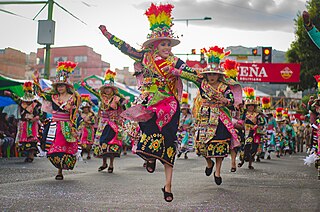
Tinku, a Bolivian Quechua tradition from Norte Potosí, began as a form of ritualistic combat. In the Quechua language, it means "meeting-encounter". During this ritual, men and women from different communities will meet and begin the festivities by dancing. The women will then form circles and begin chanting while the men proceed to fight each other; eventually the women will join in the fighting as well. Large tinkus are held in Potosí during the first few weeks of May.

Huayno is a genre of popular Andean music and dance. It is especially common in Peru, western Bolivia, northwest Argentina and northern Chile, and is popular among the indigenous peoples, especially the Quechua people. The history of Huayno dates back to colonial Peru as a combination of traditional rural folk music and popular urban dance music. High-pitched vocals are accompanied by a variety of instruments, including quena (flute), harp, siku (panpipe), accordion, saxophone, charango, lute, violin, guitar, and mandolin. Some elements of huayno originate in the music of the pre-Columbian Andes, especially on the territory of the former Inca Empire. Huayno utilizes a distinctive rhythm in which the first beat is stressed and followed by two short beats.

Cueca is a family of musical styles and associated dances from Chile, Argentina, and Bolivia. In Chile, the cueca holds the status of national dance, where it was officially declared as such by the Pinochet dictatorship on September 18, 1979.

Bersuit Vergarabat is an Argentine rock band that formed formally in 1987.

The Argentine Northwest is a geographic and historical region of Argentina composed of the provinces of Catamarca, Jujuy, La Rioja, Salta, Santiago del Estero and Tucumán.

King África is an Argentine dance music project that was founded in the early 1990s by DJ Martin Laacré. The group caught interest in 2000 due to the remake of their own 1993 song "Salta", and also for their cover version of "La Bomba" by the Bolivian group Azul Azul.

Alajuela is a canton in the Alajuela province of Costa Rica. Its head city is the provincial capital city of Alajuela.
Javier Parrado is a Bolivian classical composer, whose works have been performed in Europe, and Latin America.
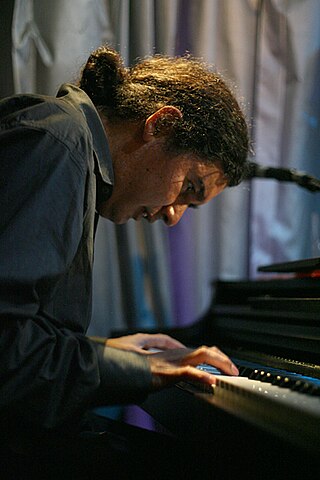
Daniel Tinte is a pianist from Argentina.

Mari Sano is a Japanese artist and composer working in multiple media, including the charango, the ocarina, percussion and photography. She lives in Mexico and Argentina. She produced three albums From Beginning (1996), Latin Park (1999) and Friendship Musical (2008). Her compositions have received awards and cultural recognition in music, photography and performance.
Bailando 2018 is the thirteenth season of Bailando por un Sueño. It started on 3 September 2018, on the El Trece network.

The Agencia Espacial Española is an agency of the Spanish government responsible for the Spanish space program. The agency was officially announced on 27 May 2021 and it became operational in 20 April 2023.

Micaela Chauque is a Qulla Argentine composer, dancer, coplista and flautist, specializing in the quena and siku. She has been lauded as one of the best interpreters of Andean music in Argentina. She is also a music teacher and luthier.

Carachipampa is a Pleistocene volcanic cone in Argentina. Part of a wider, regional volcanic field, it has produced lava flows consisting of andesite. It is surrounded by a lake and a salt flat, the former of which features an ecosystem formed by microbes.













